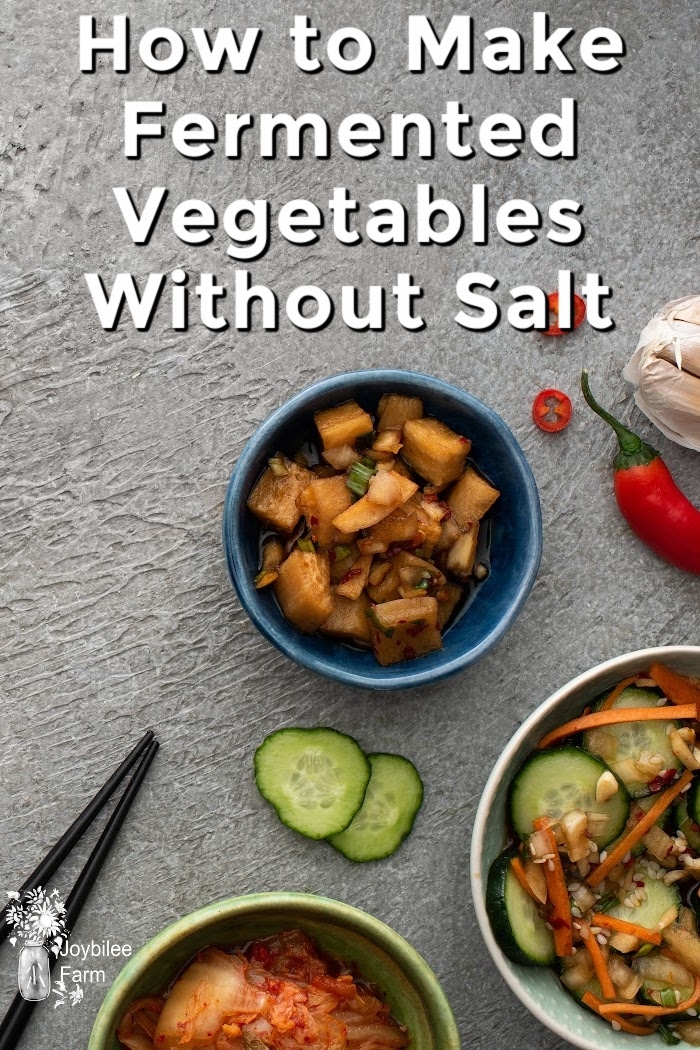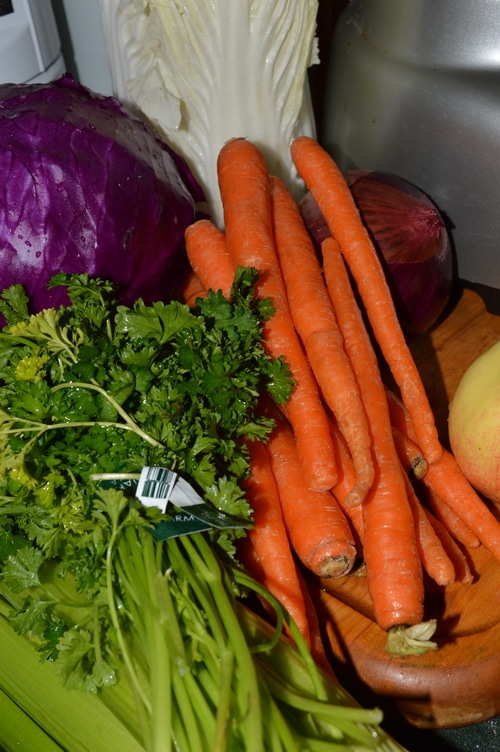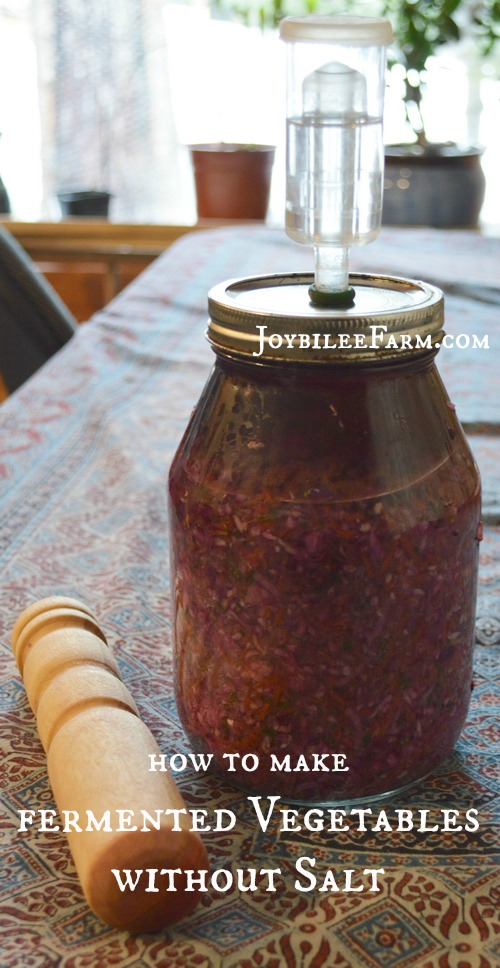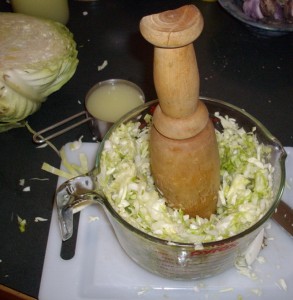How to Make Fermented Vegetables Without Salt
Here are a few ways to lessen the amount of salt used in your fermented vegetables. Use at least two of these methods with each batch to guarantee success.

Recently Kris at Attainable Sustainable asked me how to determine how much salt to use in fermented vegetables. I came across a handy chart that said that some foods need less salt than other foods and the determination of how much salt is required depends on the vegetable and the cultural tradition. It seemed very scientific — you need a scale to weigh the salt. It led me to believe that if you somehow got it wrong, you might endanger your family. But it seemed much more complicated than it needed to be. So I did some research and experimenting.
What makes vegetables ferment instead of rot?
First of all, fermented vegetables ferment instead of rot because of the natural beneficial microbes in them. The job of the cook is to give those beneficial microbes the best possible environment to thrive and multiply. At the same time, the environment needs to discourage the bad microbes that cause rot from multiplying and overpowering the mixture. This is where the salt comes in. Salt inhibits the growth of microbes.
Food that is naturally high in moisture like finely cut cabbage requires less salt than food with a hard rind, like lemons, in order to discourage the bad microbes. Food that spoils faster, like herrings, requires more salt than food that is slower to spoil, like beets. Salt also causes osmosis — a transfer of juices from the vegetables that are replaced by brine, further inhibiting spoilage.

Let’s look at what actually goes on as vegetable ferment
When you start to ferment vegetables (or dough or fish) there are hundreds of different microbes on the surface that are vying for supremacy. Whether you end up with rotting food, mold, or nicely fermented food, depends on encouraging the good microbes, while trying to crowd out the bad microbes. The good microbes thrive in an acidic environment while the bad microbes don’t. Some microbes need air to multiply while the good microbes need an anaerobic environment.
You want to begin with more of the good microbes and less of the bad. Always wash your vegetables under cold, running water before you prepare them for fermented vegetables. This washes off some of the undesirable microbes right at the beginning. Wash and sanitize knives, cutting boards, jars, and bowls before you begin to make your ferment.
Salt inhibits the growth of yeast and delays the bad microbes from reproducing and this is why salt is commonly used in fermented vegetables. Use kosher salt or sea salt rather than table salt (Iodized salt) because the addition of iodine, an antimicrobial, will inhibit the good microbes, too and discolour your vegetables.
Inoculating a jar of fermenting vegetables with the good microbes will encourage the good microbes to reproduce at a faster rate, crowding out the bad microbes. This replaces some of the need for salt in your recipe. If your recipe calls for 2 tbsp of salt per quart — if you innoculate your vegetables with good microbes you can use 2 tsp of salt instead.

The 3 stages of fermenting vegetables
| Timing | What you’ll see | What’s happening inside the jar | |
| Day 1 to 2 | Fine bubbles begin to form which break the surface when a knife is inserted inside the jar | Coliform bacteria begin the fermentation process. As it grows the mixture becomes more acidic. | |
| Day 3 to 5 | Large gaseous bubbles form inside the jar. The food is pushed up from the bottom against the weight. Unweighted food is pushed above the brine. The jar liquid overflows through the airlock. | The Leuconostoc bacteria are multiplying and continue lowering the pH in the vat. This crowds out the coliform bacteria. | |
| Day 5 to 8 | The bubbling slows down or stops. The vegetables fall down in the jar and the pressure stops building up. The ferment can be refrigerated. It will continue to develop while in storage. | The environment in the jar has become more acidic and the lacto-bacteria is thriving, while the other bacterium and yeasts are being crowded out. The lacto-bacteria are living and active inside the ferment. The fermentation can be slowed by refrigerating the ferment. It can be eaten now or the flavours can continue to develop over months. The jar contents are preserved in the acidic environment of the jar. | |
|
| The transformation of cabbage into sauerkraut involves three successive colonisations of helpful bacteria that are dependent on the acidity of the brine solution. While we speak of “Lacto-bacteria,” as the catalyst for preserving vegetables by fermentation, in reality, the Lacto-bacteria require an acidic environment, which develops gradually during the fermentation process. The pH drops within the brine as Coliform bacteria begins the fermentation process. As the environment becomes more favourable the Coliform drops off and the Leuconostoc bacteria begin to proliferate, further increasing the acidity of the brine. Finally, the conditions within the crock are acidic enough for Lactobacillus to proliferate, while the other bacteria drop off. None of this is of conscious concern to the home fermenter though. The bacteria increases or decrease as the conditions become favourable. The resulting fermentation preserves the vegetables, increases the bioavailability of vitamins and minerals, and enhances both taste and texture. |
Salt-free fermented vegetables
I was surprised to find out that salt isn’t necessary for fermentation. While it inhibits bad bacteria from proliferating before the good bacteria can crowd it out, inoculating the vat with the good bacteria will inhibit the bad without the addition of salt. The good lacto-bacteria will multiply rapidly, reducing the pH of the vat and crowding out the bad bacteria. (It’s miraculous that bad bacteria cannot survive in an acidic environment – who designed that?) Salt is also used for flavour though, so if you aren’t on a doctor’s mandated low-salt diet you may want to add a bit to taste.
Here are a few ways to lessen the amount of salt used in your fermented vegetables. Use at least two of these methods with each batch to guarantee success.

6 ways to make fermented vegetables with less salt
Celery
Add 5 stalks of celery, finely chopped to each quart of other vegetables. Or juice 5 sticks of celery and add them to the finely chopped vegetables. Celery adds flavour without extra salt.
Seaweed
Add ½ cup of dried dulse, kelp, bladderwrack, or other seaweed, per quart of vegetables. This contributes natural sodium and other trace minerals to nourish the good lacto-bacteria while inhibiting the undesirable bacteria. I buy my seaweed at Mountain Rose Herbs.
Whey
Add ½ cup of whey from cheese making or from straining yogurt to make lebna (yogurt cheese). The whey is rich in beneficial lacto-bacteria and will inoculate your fermented vegetables, crowding out the bad bacteria.
Add a starter
Take ½ cup of juice from a successful batch of fermented vegetables and use this to inoculate the new batch of fermented vegetables.
Use a probiotic capsule
You can add the contents of 3 probiotic supplement capsules to your batch of fermented vegetables to inoculate the vat. Use 3 capsules per 1 quart of prepared vegetables.
Use dried yogurt culture
When making homemade yogurt you need to begin with a starter culture. This powdered culture can also be used to inoculate fermented vegetables. Use ½ tsp in ½ cup of water, per quart of fermented vegetables.

What does it taste like?
Vegetables fermented without salt will have a sour, lemony taste – – more like a salad than a pickle. You can increase the lemony taste by adding a pinch of lemon zest before serving. They will be ready to eat in less than a week.
Try taking a batch of low-salt fermented vegetables to your next potluck for a healthy, probiotic, salad. A dash of olive oil enhances the digestibility of the fat-soluble vitamin A and beta-carotene in the fermented vegetables.
My favourite books about fermented vegetables:
The Art of Fermentation: An In-Depth Exploration of Essential Concepts and Processes from around the World
Nourishing Traditions: The Cookbook that Challenges Politically Correct Nutrition and the Diet Dictocrats
The Nourished Kitchen: Farm-to-Table Recipes for the Traditional Foods Lifestyle
Cultured Food for Life: How to Make and Serve Delicious Probiotic Foods for Better Health and Wellness
Check out these recipes for fermented vegetables:




Any of them will work.
Thank you SO much for this article. I’ve had a difficult time trying to make some items without salt. What kind/type/dosage is needed for the 3 probiotic supplement capsules? I have looked at many different ones but am unsure what will work.
Yes. That should work.
Hi, I am wondering if I can use some of the juice from the store bought Kimchi as a starter in my Korean Radish Kimchi? Also, the starter kit I bought has a huge jar, 102 Oz ,and I only want to make one small batch to see how fermenting works. Does it matter that there is so much space between the mixture and the top? Also, how does the airlock work? The included directions were very lacking.
Thank you so much,
Sally